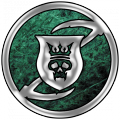Clan Cappadocian
- Bloodlines -x- Road of Bones -x- Constancia -x- Harbingers of Skulls
Introduction
The story of Clan Cappadocian is tragic, but illustrative of the parasitic cycle of Kindred existence. Nothing lasts forever in vampiric circles, but nothing ever truly dies.
The Cappadocians were a Clan that focused on death and undeath. Their founder, an ancient known simply as “Cappadocius” (“of Cappadocia”), did not attempt to rule his Clan. He asked only that they continue the search for truth and the secrets of life and death. The Clan’s ancestral roots were rumored to be somewhere in Asia Minor, but by the end of the Dark Ages they had spread throughout Europe. Known as scholars, mystics, and necromancers, the Cappadocians were as firmly entrenched in the Cainite society of their time as any of the Clans of the Camarilla are tonight.
The Graverobbers expanded their knowledge base by Embracing members of important families or promising scholars. By the 13th century they had inroads across Europe, in monasteries, universities, and in the courts of royalty, but also members and ghouls among the working classes. Everyone must eventually die, the Cappadocians realized, and every death was potentially a lesson.
Their inclusive attitude may have spelled the Clan’s doom. They accepted a Venetian merchant family called the Giovanni (the family’s propensity for summoning up and controlling ghosts had as much to do with their Embrace as their skill with finance). Over the following centuries, the Giovanni worked their way into the hierarchy of the Clan, until Augustus Giovanni committed diablerie upon Cappadocius. Over the next few centuries, the Giovanni systematically destroyed the remaining Cappadocians. In modern nights, only small remnants survive, such as the Harbingers of Skulls. The lineage of these remnants is largely unknown.
Nickname: Graverobbers
Sect: The Cappadocians did not survive long enough to take a side in the Camarilla/Sabbat divide.
Appearance: The Graverobbers were pale and corpse-like, even for vampires. Their hair often darkened slightly after the Embrace, giving them even more of an ethereal appearance. The Cappadocians dressed appropriately for their station and role.
Haven: Cappadocians preferred a measure of solitude when choosing their havens. Although they had to stay close enough to mortals to feed, they often chose quiet locales to make their homes — monasteries, crypts, and even sewers or cisterns. The Cappadocians acting as scholars or advisors enjoyed a better standard of unlife, but even they often chose places that mortals had no interest in exploring.
Background: As a general rule, the Cappadocians were not concerned with ethnicity or nationality when Embracing, meaning that it wasn’t uncommon to find Moors, Jews, or even pagans brought into the Clan. The Graverobbers were more inclined to Embrace people with an interest in death. That didn’t necessarily mean causing death (though certainly they Embraced their share of soldiers and hunters), but scholars of the afterlife and religion, gravediggers, priests, and hermits all found their way to Clan Cappadocian.
Character Creation: Mental Attributes and Knowledges were often primary, and rare was the Cappadocian without at least a few dots of Occult. The Clan included warriors as well as scholars and priests, and a Cappadocian who chose to be a tyrant could be a frightening creature indeed. For the most part, though, the Clan tended more toward intellectual and spiritual pursuits, and choices of Abilities and Backgrounds reflected that.
Clan Disciplines: Auspex, Fortitude, Necromancy
Weakness: As mentioned, the Cappadocians exhibited a deathly pallor, and this only worsened as the vampire grew older. Young Cappadocians were able to pass for human (though mortals that knew what to look for could pick them out easily), but elder Cappadocians showed shriveled skin and a much more withered countenance.
Organization: Clan Cappadocian was, in its heyday,
an important Clan historically. It claimed domain in
several important cities across Europe, and it wasn’t
uncommon for Graverobbers to act as spiritual or mystical
advisors to other medieval Princes. Internally, the
Clan had little strict hierarchy, though as the years
wore on the Clan’s core became more localized around
the founder (which, in turn, allowed the Giovanni to
take it over).
3rd Generation
- -- Cappadocius (deceased, but not fully dead)
4th Generation
- -- Caius the Elder -- deceased -- slain with vile Serpentis, sometime after the First Crusade by his younger brother Lazarus
- -- Japheth -- The Second Son (believed to have been diablerized by Claudius Giovanni in 1444)
- -- Lazarus -- The Third and Prodigal Son (missing for centuries, probably dead)
- -- Byzar/Mahatma -- Progeny of Laodice/Cappadocius and sire of Alexia Theusa.
5th Generation
- -- Abraham --
- -- Alexia Theusa -- Progeny of Byzar. Ambushes Byzar and Constantinople's Cappadocians in 196, sending them into torpor.
- -- Angelique -- Progeny of Lazarus and Guardian of the Necropoli.
- -- Constancia -- Matriarch of Bones (missing -- believed to be dead)
- -- Jairus -- Progeny of Lazarus
- -- Kyros of Antioch --
- -- Lamia --
- -- Troglodytia --
- -- Unre --
6th Generation
7th Generation
- -- Bela Rusenko -- The 3rd Prince of Sofia (deceased -- believed to have been destroyed by the Giovanni during their great purge of the former clan of death)
8th Generation
9th Generation
10th Generation
11th Generation
12th Generation
13th Generation
Those Unknown Generation
